|

What
causes poor indoor air quality?
Indoor air pollution can be easy to manage
once you understand where it comes from. Looking
at the image above gives you some idea of the more
common sources for poor indoor air quality. In
many cases, it comes from chemicals that are part
of the things that you bring into your home; the
polyurethane common in mattresses, formaldehyde
and organic chemicals like dioxin, polychlorinated
biphenyl (PCB) and polybrominated biphenyl (PBB)
used in lots of furniture and other interior elements
are all harmful to us humans. Drapes, carpets and
other absorbent fabrics can help trap these nasties,
along with dust, mites and other allergens, and
our modern, mostly airtight homes keep them inside.

Common Household Chemical Exposures
Symptoms (list is not all inclusive): Brain fog,
irritability, altered mood, fatigue, headaches,
tremors, vertigo, numbness, loss of balance, memory
loss, learning difficulties, depression, asthma,
cough, dry throat, stomach pain, loss of appetite,
diarrhea, constipation, skin rashes, muscle weakness
or spasms, impaired sleep, hormone imbalance, breast
tenderness, PMS like symptoms, menstrual cycle
deviations, sweating, flushing, unusual paleness,
loss of libido, and low sperm count.
|
The Hidden
Air Pollutants in Your Home
According to the Environmental Protection
Agency, the top five air quality problems in the U.S. are
all indoor air problems. Common residential indoor pollutants
include excessive moisture, volatile organic compounds
(VOCs), combustion products, radon, pesticides, dust particles,
viruses, and bacteria.
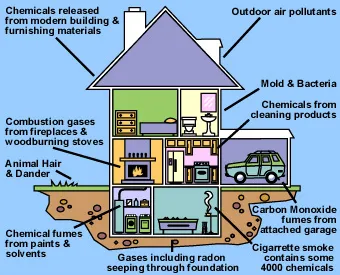
What is PM2.5 and Why You Should Care
PM2.5 readings are often included in air quality reports
from environmental authorities and companies. Find out
what they mean and why you should monitor their levels.
| “Exposure to PM <2.5 µm in diameter
(PM2.5) over a few hours to weeks can trigger cardiovascular
disease-related mortality and nonfatal events; longer-term
exposure (eg, a few years) increases the risk for cardiovascular
mortality to an even greater extent than exposures
over a few days and reduces life expectancy within
more highly exposed segments of the population by several
months to a few years.” |
PM2.5 refers to atmospheric particulate matter (PM) that
have a diameter of less than 2.5 micrometers, which is
about 3% the diameter of a human hair.

Fine particles can come from various
sources. They include power plants, motor vehicles, airplanes,
residential wood burning, forest fires, agricultural
burning, volcanic eruptions and dust storms. Some are emitted
directly into the air, while others are formed when gases
and particles interact with one
another in the atmosphere.

Why Are PM2.5 Dangerous
Since they are so small and light, fine particles tend
to stay longer in the air than heavier particles. This
increases the chances of humans and animals inhaling
them into the bodies. Owing to their minute size, particles
smaller than 2.5 micrometers are able to bypass the nose
and throat and penetrate deep into the lungs and some
may even enter the circulatory system.

Innocent
Studies have found a close link between exposure to
fine particles and premature death from heart and lung
disease. Fine particles are also known to trigger or
worsen chronic disease such as asthma, heart attack,
bronchitis and other respiratory problems.
.webp)
A study published in the Journal of the American Medical
Association suggests that long-term exposure to PM2.5
may lead to plaque deposits in arteries, causing vascular
inflammation and a hardening of the arteries which can
eventually lead to heart attack and stroke. Scientists
in the study estimated that for every 10 micrograms per
cubic meter (µg/m3) increase in fine particulate
air pollution, there is an associated 4%, 6% and 8% increased
risk of all-cause, cardiopulmonary and lung cancer mortality,
respectively. Source
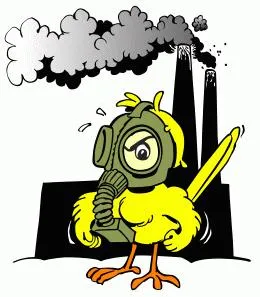
PM 1 The smaller the SIZE of the particulate,
the greater the toxicity. Very small particulate
(diameter less than 2.5 micrometer) is the most toxic
for human being, because:
1) it can easily get the respiratory system in deep and
go into the blood Add your answer
2) particles have adsorbed important toxic element as
heavy metals and hydrocarbons, because they are usually
produced by combustion processes; while the larger particulate
is usually produced by natural or anthropic erosive processesA
great publication to read would be http://www.europeanreview.org/wp/wp-content/uploads/824.pdf
Institute for Environmental Protection and Research (ISPRA)
Did
you know...
5 billions of pounds of chemicals
that the institutional cleaning industry uses each
year
275 active ingredients in antimicrobials that the EPA classifies as pesticides
Indoor pollution levels can be up to 100 times as much as outdoors
In the average American home, there are 63 synthetic chemical products
23 gallons, or 87 liters, that a
conventional janitor uses every year = 25% hazardous
90% time spent indoors
Only 30% of the 17,000 petrochemicals available for home use have been
tested for human health and environmental exposure |
PM 10 The growing awareness of PM10 is largely
associated with the potential damaging effects
they can have on the human body. The World Health Organisation
(WHO) believes particles are affecting more people worldwide
than any other pollutant. Primary health effects include
damage to the respiratory and cardiovascular systems. Due
to the small size of PM10 particles, they can
penetrate the deepest parts of the lungs as well as access
the gas exchange regions of the lung via diffusion.

"Formaldehyde
(HCHO) is the most important carcinogen
in outdoor air among the 187 hazardous air pollutants (HAPs).
Colorless, poisonous, highly water-soluble gas with an
obnoxious odor. Used in the manufacture of
disinfectants,
preservatives, and hundreds of industrial and consumer
products such as adhesives, carpeting, decorative
paneling, foam insulation, drapery, fiber and particle
boards, and permanent press fabrics. Formaldehyde
is a prominent factor
in sick-building syndrome (SBS) as its emissions (accelerated
by heat and moisture) irritate eyes and mucous membranes
in nose and throat, and cause headache and dizziness.
Officially named as methanal (not to be confused with methanol),
it
is classified as a possible carcinogen by EPA."
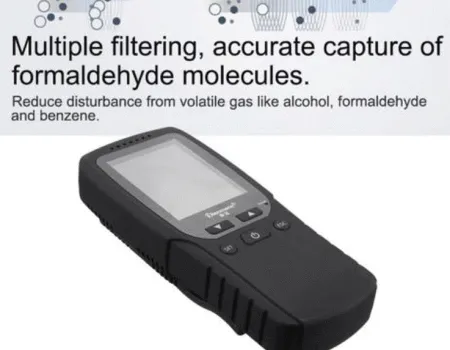
TVOC What are TVOCs? TVOCs stands for Total Volatile Organic
Compounds, which are the total amount of any emitted gases
with short or long-term health effects.
Volatile organic compounds (VOCs) are considered to be emitted
harmful, carcinogenic gases from solids and liquids. VOC
concentrations are consistently higher indoors (up to 10
times, according to the U.S. EPA) than outdoors and are found
in common household products and furnishings. TVOC (ppm)
is the concentration of VOCs present in the air. The TVOC
index uses TVOC (ppm) to communicate the level of VOCs in
your surroundings.

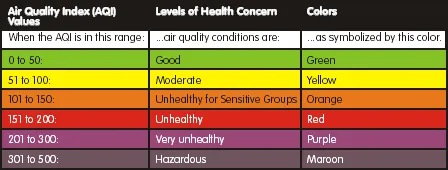
The Air Quality Index is a tool used
by EPA and other
agencies to provide the public with timely and
easy-to-understand information on local air quality
and whether air pollution levels pose a health concern.
The AQI tells the public how clean the air is and
whether or not they should be concerned for their
health. The AQI is focused on health effects that
can happen within a few hours or days after breathing
polluted air. |
In Some countries your local weather forecast
say that tomorrow will be a "code orange" day
for air pollution? That's the Air
Quality Index at work. The
Air
Quality Index,
or AQI, is the system used to warn the public when air
pollution is dangerous. The AQI tracks ozone (smog) and
particle pollution (tiny particles from ash, power plants
and factories, vehicle exhaust, soil dust, pollen, and
other pollution), as well as four other widespread air
pollutants. Newspapers, radio, television, and websites
report AQI levels year-round. Keeping track of the current
air quality information can help you take steps to protect
yourself, children, and others from unhealthy levels of
air pollution.
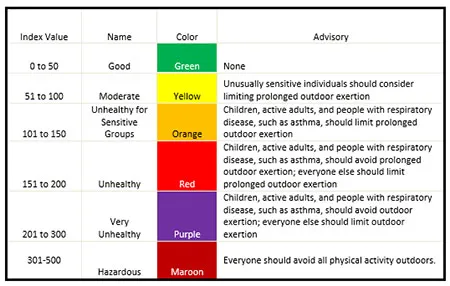
Air Quality Meter

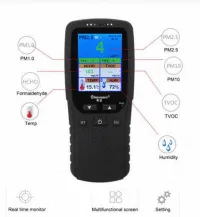 |
8 in 1 PM1.0 PM2.5 PM10 Monitor TVOC HCHO
Formaldehyd Detector Temperature Humidity Meter Air Quality
Monitor Gas
Analyzer
Detect
PM1
PM2.5
PM10
HCHO
TVOC
Humidity
Temperature
AQI
Air quality index
|
|

